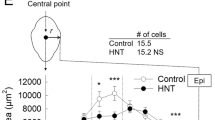Abstract
It has recently been emphasised that the intracellular pH of plant cells must be actively regulated to offset acid–base imbalances that occur during metabolism and solute uptake (for review see ref. 1). Changes in cytoplasmic pH might be important (1) in controlling various aspects of metabolism2, including enzyme activities responsible for malate synthesis during cation accumulation1,2, (2) in polar transport of the plant hormone, auxin3, and (3) in intracellular responses to substances such as auxin and the phytotoxin fusicoccin, which cause proton extrusion1,4,5. Almost no direct measurements of cytoplasmic pH have been made on the small cells typical of higher plants1. The task is hampered by the presence of a generally acidic vacuole which occupies much of the cell volume. Use of the indirect method of 14C-5, 5-dimethyloxazolidine-2, 4-dione (DMO) distribution is subject to considerable uncertainties because of corrections needed for vacuolar pH and volume, and DMO metabolism6,7. Here we report the use of 31P nuclear magnetic resonance (NMR) to estimate the pH of vacuole and cytoplasm in maize root tips.
This is a preview of subscription content, access via your institution
Access options
Subscribe to this journal
Receive 51 print issues and online access
$199.00 per year
only $3.90 per issue
Buy this article
- Purchase on Springer Link
- Instant access to full article PDF
Prices may be subject to local taxes which are calculated during checkout
Similar content being viewed by others
References
Smith, F. A. & Raven, J. A. A. Rev. Pl. Physiol. 30, 289–311 (1979).
Davies, D. D. Symp. Soc. exp. Biol. 27, 513–529 (1973); A. Rev. Pl. Physiol. 30, 131–158 (1979).
Rubery, P. H. Planta 144, 173–178 (1979).
Rayle, D. L. & Cleland, R. E. Curr. Topics dev. Biol. 11, 187–214 (1977).
Marrè, E. A. Rev. Pl. Physiol. 30, 273–288 (1979).
Kurkdjian, A. & Guern, J. Pl. Sci. Lett. 11, 337–344 (1978).
Kurkdjian, A., Leguay, J. J. & Guern, J. Resp. Physiol. 33, 70–89 (1978).
Moon, R. B. & Richards, J. H. J. biol. Chem. 248, 7276–7278 (1973).
Burt, C. T., Cohen, S. M. & Barany, M. A. Rev. Biophys. Bioengng. 8, 1–25 (1979).
Effer, W. R. & Ranson, S. L. Pl. Physiol. 42, 1053–1058 (1967).
Givan, C. V. Pl. Physiol. 43, 948–952 (1968).
Abdul-Baki, A. A. & Ray, P. M. Pl. Physiol. 47, 537–544 (1971).
Loughman, B. C. in Perspectives in Experimental Biology Vol. 2 (ed Sunderland, N). 423–431 (Pergamon, Oxford, 1976).
Bergmeyer, H. U. Methods of Enzymatic Analysis (Academic, New York, 1963).
McComb, R. B. & Yushok, W. D. Cancer Res. 24 part 1, 193–197 (1964).
Biely, P. & Bauer, S. Biochim. biophys. Acta. 121, 213–214 (1966); Colin. Czech. Chem. Commun. Engl. Edn. 32, 1588–1594 (1967).
Author information
Authors and Affiliations
Rights and permissions
About this article
Cite this article
Roberts, J., Ray, P., Wade-Jardetzky, N. et al. Estimation of cytoplasmic and vacuolar pH in higher plant cells by 31P NMR. Nature 283, 870–872 (1980). https://doi.org/10.1038/283870a0
Received:
Accepted:
Issue Date:
DOI: https://doi.org/10.1038/283870a0
This article is cited by
-
Unrevealing metabolomics for abiotic stress adaptation and tolerance in plants
Journal of Crop Science and Biotechnology (2021)
-
Identification of plant vacuolar transporters mediating phosphate storage
Nature Communications (2016)
-
Osmolyte cooperation affects turgor dynamics in plants
Scientific Reports (2016)
-
Carbonic anhydrase: a key regulatory and detoxifying enzyme for Karst plants
Planta (2014)
-
Vertical variations and associated ecological function of bacterial communities from Sphagnum to underlying sediments in Dajiuhu Peatland
Science China Earth Sciences (2014)
Comments
By submitting a comment you agree to abide by our Terms and Community Guidelines. If you find something abusive or that does not comply with our terms or guidelines please flag it as inappropriate.



